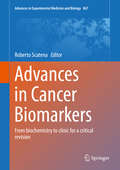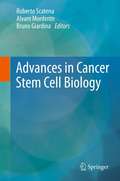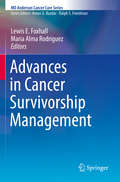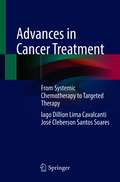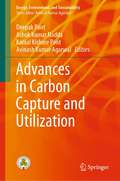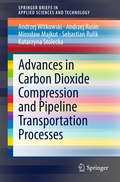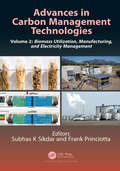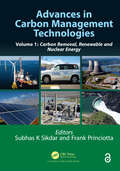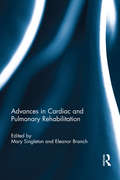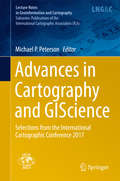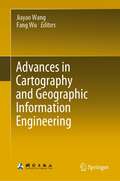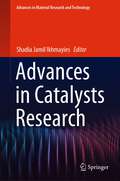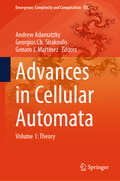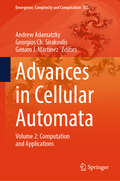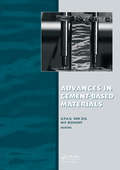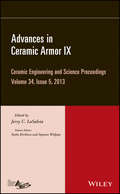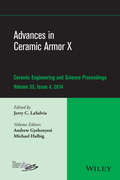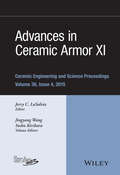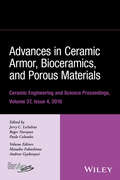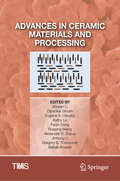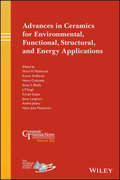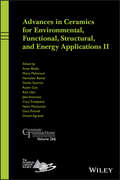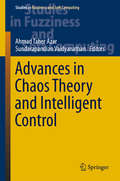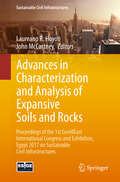- Table View
- List View
Advances in Cancer Biomarkers: From biochemistry to clinic for a critical revision (Advances in Experimental Medicine and Biology #867)
by Roberto ScatenaAt present there are a growing number of biomolecules under investigation to understand their potential role as cancer biomarker for diagnostic, prognostic and therapeutic purposes. Intriguingly, the state of art on cancer biomarkers research shows interesting and promising results together to clamorous failures. Also from a clinical point of view, there are contradictory results on routine clinical use of the present cancer biomarkers. Some patients may be simply monitored in their course by a periodic blood sample, but sometimes this monitoring shows dramatic limits. A lot of patients show serious and extensive relapses without significant change in serum concentrations of biomarkers tested. Often the physician who should utilize these biomarker does not entirely know their limits and the total potential applications as well and sometimes this knowledge is influenced by economical and marketing strategies. This limited and "polluted" knowledge may have dramatic consequences for patient. The aim of this book is to diffuse all aspects of cancer biomarkers, from their biochemical peculiarities to all clinical implications by passing through their physiology and pathophysiology. This critical approach towards old and new cancer biomarkers should foster a deepened and useful understanding of the diagnostic and prognostic index of these fundamental parameters of laboratory medicine and in the same time facilitating the research of new and more sensitive-specific signals of the cancer cell proliferation.
Advances in Cancer Stem Cell Biology
by Alvaro Mordente Bruno Giardina Roberto ScatenaIn recent years, cancer stem cells have been recognized as important component in carcinogenesis and they seem to form the basis of many (if not all) tumor types. Cancer stem cells or "cancer cell like stem cells" have been isolated from various cancers of different origin (blood, breast, brain, skin, head and neck, thyroid, cervix, lung, retina, colon, pancreas and so on). Cancer stem cells - rare cells with indefinite proliferative potential that drive the formation and growth of tumours- seem to show intriguing relationships with physiological stem cells. Specifically, these cancer cells show significant similarities in the mechanisms that regulate self-renewal of normal stem cells. Moreover, tumour cells might directly arise from normal stem cells. Further, the cellular biology of cancer stem cells show a lot of similarities with normal stem cells.
Advances in Cancer Survivorship Management (MD Anderson Cancer Care Series)
by Lewis E. Foxhall Maria Alma RodriguezThis volume presents the MD Anderson experience in providing care and services to the rapidly growing population of cancer survivors, which is currently estimated to be 12 million in the United States and more than 25 million worldwide. As cancer survival rates have increased, it has slowly become clear that the challenges faced by people with cancer do not end with treatment but simply change. This book aims to assist community oncologists, physicians, and their staff, who care for the vast majority of cancer survivors, by disseminating models of surveillance for disease recurrence, screening for second primary cancers, education regarding potential late effects of treatment, and psychosocial counseling. These models have proven valuable to cancer survivors who receive care at MD Anderson.
Advances in Cancer Treatment: From Systemic Chemotherapy to Targeted Therapy
by Iago Dillion Cavalcanti José Cleberson SoaresThis work covers the pathophysiology of cancer, exploring the difficulty of optimal treatment due to the complexity and diversity of cancer types. The search for distinctive molecular biology characteristics of tumor cells is especially relevant in the identification of overexpressed receptors and proteins that can be used as a target for cancer treatment.We highlight the main therapeutic modalities, particularly conventional systemic chemotherapy, addressing its mechanisms of action, therapeutic classes and even the toxic effects. We also describe the main tumor markers, their importance in the diagnosis and treatment of cancer, and the specificity of tumor cells. The first chapters serve as an introduction to the central topic of this book, targeted therapy. Key aspects of target therapy, such as classes of drugs, immunotherapy, monoclonal antibodies, checkpoint inhibitors, cancer vaccines and tyrosine kinase inhibitors are presented, and, for each one, the benefits, as well as the adverse effects are reported. Chapter 6 compares conventional systemic chemotherapy and targeted therapy, identifies the risks and benefits and also the eligibility criteria for patient care. The possibility of targeted therapy replacing conventional chemotherapy is discussed while reviewing studies that demonstrate the benefits of combining both types of treatment. Finally, the introduction of pharmaceutical nanotechnology to improve antineoplastic agents is addressed in the last chapter and sets the direction for future research in cancer treatment. This is a valuable resource for many health professionals including physicians, pharmacists, nurses, researchers and students interested in the field of oncology.
Advances in Carbon Capture and Utilization (Energy, Environment, and Sustainability)
by Deepak Pant Avinash Kumar Agarwal Ashok Kumar Nadda Kamal Kishore PantThis book focuses on the recent trends in carbon management and up-to-date information on different carbon management strategies that lead to manage increasing concentration of atmospheric carbon dioxide. The growing evidence of climate change resulting from the continued increase of atmospheric carbon dioxide concentration has made it a high profile political–social and trade issue. The mean global average earth temperature rose by 0.6± 2°C during the second half of the century with the rate of 0.17°C/decade. As per GISS data in the year of 2017, it rose 0.9°C (1.62 °F) above the 1951-1980 mean global temperature. Recently World Meteorological Organization analyzes the past record temperature and found the past 10 years were the warmest years about 1.1°C above preindustrial level. Over the past decade, carbon management by various techniques has to come to fore as a way to manage carbon dioxide emissions contributing to climate change. The proposed book addresses the need for an understanding of sustainable carbon dioxide management technologies mainly focused on (a) minimizing carbon dioxide emission from sources; (b) maximizing environmentally sound recuse, reduce and recycling; (c)emerging technology toward carbon dioxide mitigation and d) converting carbon dioxide into valuable products form sustainable use. Other books related to carbon management attempt to cover the carbon capture and sequestration, carbon mineralization, utilization and storage but the topic of CO2 management strategies is not discussed in detail for sustainable development. Furthermore, this book also covers all physical, chemical and biological process for long-term capture, removal and sequestration of carbon dioxide from the atmosphere for sustainable management which is not described in other carbon management books. In order to meet CO2 emissions reduction target, a range of technological approaches, including development of clean fuels and clean coal technologies, adopting cleaner and more energy efficiency and conservation, developing renewable energy and implementing CCS technologies, will also be considered for sustainable future.
Advances in Carbon Dioxide Compression and Pipeline Transportation Processes (SpringerBriefs in Applied Sciences and Technology)
by Andrzej Witkowski Andrzej Rusin Mirosław Majkut Sebastian Rulik Katarzyna StoleckaProviding a comprehensive analysis of CO2 compression, transportation processes and safety issues for post combustion CO2 capture applications for a 900 MW pulverized hard coal-fired power plant, this book assesses techniques for boosting the pressure of CO2 to pipeline pressure values with a minimal amount of energy. Four different types of compressors are examined in detail: a conventional multistage centrifugal compressor, integrally geared centrifugal compressor, supersonic shock wave compressor, and pump machines. The study demonstrates that the total compression power is closely related to the thermodynamic process and is not determined by compressor efficiency alone. Another problem addressed is that of CO2 pipeline transport from the compressor outlet site to a disposal site under heat transfer conditions. The book also features an analysis of simulations and models that are used to determine the maximum safe pipeline distance to subsequent booster stations as a function of inlet pressure, ambient temperature, thickness of the thermal insulation and ground-level heat flux conditions. This book focuses on compression as well as transportation processes with particular emphasis on the safety risks related to the transport of CO2. The most important problem in terms of environmental protection is ensuring precise and reliable hazard identification. As hazards can only be managed effectively if they are properly identified, problems involving the discharge and atmospheric dispersion of CO2 are also discussed.
Advances in Carbon Management Technologies: Biomass Utilization, Manufacturing, and Electricity Management, Volume 2
by Subhas K Sikdar and Frank PrinciottaVolume 2 of Advances in Carbon Management Technologies has 21 chapters. It presents the introductory chapter again, for framing the challenges that confront the proposed solutions discussed in this volume. Section 4 presents various ways biomass and biomass wastes can be manipulated to provide a low-carbon footprint of the generation of power, heat and co-products, and of recovery and reuse of biomass wastes for beneficial purposes. Section 5 provides potential carbon management solutions in urban and manufacturing environments. This section also provides state-of the-art of battery technologies for the transportation sector. The chapters in section 6 deals with electricity and the grid, and how decarbonization can be practiced in the electricity sector. The overall topic of advances in carbon management is too broad to be covered in a book of this size. It was not intended to cover every possible aspect that is relevant to the topic. Attempts were made, however, to highlight the most important issues of decarbonization from technological viewpoints. Over the years carbon intensity of products and processes has decreased, but the proportion of energy derived from fossil fuels has been stubornly stuck at about 80%. This has occurred despite very rapid development of renewable fuels, because at the same time the use of fossil fuels has also increased. Thus, the challenges are truly daunting. It is hoped that the technology choices provided here will show the myriad ways that solutions will evolve. While policy decisions are the driving forces for technology development, the book was not designed to cover policy solutions.
Advances in Carbon Management Technologies: Carbon Removal, Renewable and Nuclear Energy, Volume 1
by Frank Princiotta Subhas K SikdarAdvances in Carbon Management Technologies comprises 43 chapters contributed by experts from all over the world. Volume 1 of the book, containing 23 chapters, discusses the status of technologies capable of yielding substantial reduction of carbon dioxide emissions from major combustion sources. Such technologies include renewable energy sources that can replace fossil fuels and technologies to capture CO2 after fossil fuel combustion or directly from the atmosphere, with subsequent permanent long-term storage. The introductory chapter emphasizes the gravity of the issues related to greenhouse gas emissionglobal temperature correlation, the state of the art of key technologies and the necessary emission reductions needed to meet international warming targets. Section 1 deals with global challenges associated with key fossil fuel mitigation technologies, including removing CO2 from the atmosphere, and emission measurements. Section 2 presents technological choices for coal, petroleum, and natural gas for the purpose of reducing carbon footprints associated with the utilization of such fuels. Section 3 deals with promising contributions of alternatives to fossil fuels, such as hydropower, nuclear, solar photovoltaics, and wind.
Advances in Cardiac and Pulmonary Rehabilitation
by Susan S Rose Eleanor F BranchEnhance your rehabilitation program with this authoritative volume. Experts from the Department of Physical Therapy of Duke University Medical Center in Durham, North Carolina, explore the most current developments in cardiac and pulmonary rehabilitation. Reading this highly practical volume will provide you with insight into the current status and future trends of pulmonary rehabilitation, supply you with rationale and supporting data for physiological and psychological mechanisms that seem to influence the pulmonary rehabilitation process, and illustrate the successes of both a hospital-based and a community-based pulmonary rehabilitation program. Valuable chapters on the physical therapy interventions required by and designed for coronary bypass surgery patients and heart transplantation patients will offer you additional useful information. Advances in Cardiac and Pulmonary Rehabilitation is an ideal resource for professionals, including physical therapists, who are or who wish to become, involved in the care of patients with cardiac or chronic pulmonary disorders.
Advances in Cartography and GIScience: Selections from the International Cartographic Conference 2017 (Lecture Notes in Geoinformation and Cartography)
by Michael P. PetersonThis book presents a selection of manuscripts submitted to the 2017 International Cartographic Conference held in Washington, DC at the beginning of July and made available at the conference. These manuscripts have been selected by the Scientific Program Committee and represent the wide-range of research that is done in the discipline. It also forms an important international collection representing research from at least 30-40 countries.
Advances in Cartography and Geographic Information Engineering
by Jiayao Wang Fang WuThis book reviews and summarizes the development and achievement in cartography and geographic information engineering in China over the past 60 years after the founding of the People's Republic of China. It comprehensively reflects cartography, as a traditional discipline, has almost the same long history with the world's first culture and has experienced extraordinary and great changes. The book consists of nineteen thematic chapters. Each chapter is in accordance with the unified directory structure, introduction, development process, major study achievements, problem and prospect, representative works, as well as a lot of references. It is useful as a reference both for scientists and technicians who are engaged in teaching, researching and engineering of cartography and geographic information engineering.
Advances in Catalysts Research (Advances in Material Research and Technology)
by Shadia Jamil IkhmayiesThis book covers various subtopics of catalyst research. It provides essential background material on key concepts in catalyst technologies, along with recent developments in synthesis methods. The book delves into diverse areas such as photocatalysis, electrocatalysis, biocatalysis, and heterogeneous catalysis, offering a detailed exploration of their respective advancements, advantages, disadvantages, and applications in different catalytic reactions. It also presents fundamental ideas and overviews of noble-metal-free bifunctional electrocatalysts for overall water splitting in alkaline medium, catalytic nitrite reduction, and the utilization of catalysts supported on various materials like CeO2, Nb2O5, ZrO2, TiO2, γ-Al2O3, SiO2, and ZSM-5 for the removal of high concentrations of nitrite in water. Moreover, the book provides insights into topics such as polyphenol oxidase mimics as catalysts, ferrites nanoparticles/graphene oxide nanoparticles and their composites as enzyme mimics and photocatalysts, electrochemical approaches with basic concepts and materials for hydrogen technologies, as well as recent advances and applications of modified-semiconductor photocatalysts in pollutant degradation. For scientists and researchers, the book offers a wealth of recent experimental and computational results, along with in-depth discussions. Some of the specific areas covered include sphalerite ZnS nanoparticles (NPs) synthesized via solvothermal method, incorporating various ruthenium (Ru) concentrations. Additionally, the book explores the modification of TiO2 as SO4/TiO2 acid and CaO/TiO2 base catalysts, and their applications in converting waste frying oil into biodiesel.
Advances in Celiac Disease: Improving Paediatric and Adult Care
by Jorge Amil-Dias Isabel PolancoThis book provides a practical overview of the treatment and management of celiac disease. It examines new data which can be merged with clinical aspects to provide a global perspective for the busy clinician. The disease represents 1% of the population and often goes unnoticed for a long time; however, this book aims to reduce the instance of misdiagnoses of symptoms by providing clear guidance in a single book, with contributions from esteemed experts in the field. Advances in Celiac Disease - Improving Paediatric and Adult Care addresses the clinical characterisation of the disease, in both paediatric and adult populations. The clinical symptoms are clearly defined as well as treatment options and follow-up. This book will be an essential resource for clinicians seeking a clear, concise resource to identifying, treating, and managing celiac disease in both adults and children.
Advances in Cellular Automata: Volume 1: Theory (Emergence, Complexity and Computation #52)
by Georgios Ch. Sirakoulis Andrew Adamatzky Genaro J. MartinezThis book embarks on a journey through the captivating universe of cellular automata and discover its distinct realm, characterised by discrete time, space, and states, where cells form regular patterns and offer insights into complex systems across various domains. From theoretical foundations to practical applications, each chapter unveils innovative ideas and implementations, from solving initial value problems to exploring reversible computing and real-time pattern generation. Explore hyperbolic spaces, analyse elementary automata, and delve into network growth dynamics. Shedding light on synchronisation, control, and computational structures, this book is an invaluable resource for computer scientists, modellers, mathematicians, engineers, physicists, and professionals across disciplines. Immerse yourself in the intricate complexities and boundless potential of cellular automata, whether unravelling pedestrian dynamics or exploring cryptographic applications.
Advances in Cellular Automata: Volume 2: Computation and Applications (Emergence, Complexity and Computation #53)
by Georgios Ch. Sirakoulis Andrew Adamatzky Genaro J. MartinezThis book embarks on a journey through the captivating universe of cellular automata and discover its distinct realm, characterised by discrete time, space, and states, where cells form regular patterns and offer insights into complex systems across various domains. From theoretical foundations to practical applications, each chapter unveils innovative ideas and implementations, from solving initial value problems to exploring reversible computing and real-time pattern generation. Explore hyperbolic spaces, analyse elementary automata, and delve into network growth dynamics. Shedding light on synchronisation, control, and computational structures, this book is an invaluable resource for computer scientists, modellers, mathematicians, engineers, physicists, and professionals across disciplines. Immerse yourself in the intricate complexities and boundless potential of cellular automata, whether unravelling pedestrian dynamics or exploring cryptographic applications.
Advances in Cement-Based Materials: Proc. Int. Conf. Advanced Concrete Materials, 17-19 Nov. 2009, Stellenbosch, South Africa
by G.P.A.G. van Zijl W. P. BoshoffCollection of selected papers on current advances in high performance construction materials. Contributions deal with the development, characterization, application procedures, performance and structural design of materials with key potential in civil engineering works. Materials treated are fibre reinforced concrete, high performance concrete, sel
Advances in Ceramic Armor IX: Ceramic Engineering and Science Proceedings, Volume 34 Issue 5
by Soshu Kirihara Sujanto Widjaja Jerry C. LasalviaCeramic Engineering and Science Proceedings Volume 34, Issue 5 - Advances in Ceramic Armor IX A collection of 14 papers from The American Ceramic Society's 37th International Conference on Advanced Ceramics and Composites, held in Daytona Beach, Florida, January 27-February 1, 2013.This issue includes papers presented in the Armor Ceramics Symposium on topics such as Manufacturing; High-Rate Real-Time Characterization; Microstructural Design; Nondestructive Characterization; and Phenomenology and Mechanics of Ceramics Subjected to Ballistic Impact.
Advances in Ceramic Armor X
by Andrew L. Gyekenyesi Jerry C. Lasalvia Michael HalbigA collection of 14 papers from the Armor Ceramics symposium held during The American Ceramic Society's 38th International Conference on Advanced Ceramics and Composites, held in Daytona Beach, Florida, January 26-31, 2014.
Advances in Ceramic Armor XI
by Soshu Kirihara Jingyang Wang Jerry C. LaSalviaThe Ceramic Engineering and Science Proceeding has been published by The American Ceramic Society since 1980. This series contains a collection of papers dealing with issues in both traditional ceramics (i.e., glass, whitewares, refractories, and porcelain enamel) and advanced ceramics. Topics covered in the area of advanced ceramic include bioceramics, nanomaterials, composites, solid oxide fuel cells, mechanical properties and structural design, advanced ceramic coatings, ceramic armor, porous ceramics, and more.
Advances in Ceramic Armor, Bioceramics, and Porous Materials
by Roger Narayan Paolo Colombo Manabu Fukushima Andrew Gyekenyesi Jerry C. LaSalviaA collection of 17 papers from thee popular symposia - Symposium 4: Armor Ceramics; Symposium 5: Next Generation Bioceramics and Biocomposites; and Symposium 9: Porous Ceramics: Novel Developments and Applications held during The American Ceramic Society’s 40th International Conference on Advanced Ceramics and Composites, held in Daytona Beach, Florida, January 24-29, 2016.
Advances in Ceramic Materials and Processing (The Minerals, Metals & Materials Series)
by Kathy Lu Bowen Li Faqin Dong Eugene A. Olevsky Babak Anasori Jinhong Li Ruigang Wang Dipankar Ghosh Alexander D. Dupuy Gregory B. ThompsonThis collection emphasizes the advances of powder and ceramic/glass materials in fundamental research, technology development, and industrial applications. Ceramic materials science covers the science and technology of creating objects from inorganic, non-metallic materials, and includes design, synthesis, and fabrication of ceramics, glasses, advanced concretes, and ceramic-metal composites. In recent years, the hybrids of ceramic and metallic materials have received plenty of interdisciplinary inspirations and achievements in material processes and functional applications including ionic conductors, catalysis, energy conversion and storage, superconductors, semiconductors, and filtrations. Topics include but are not limited to: Silicates, oxides, and non-oxide ceramics and glasses Synthesis, characterization, modeling, and simulation of ceramic materials Design and control of ceramic microstructure and properties Ceramic powders and processing Catalyst and catalyst support materials Fundamental understanding of ceramic materials and processes Novel methods, techniques, and instruments used to characterize ceramics and glasses High entropy ceramics Bioceramics, electronic, magnetic ceramics, and applications Surface treatment and ceramic thin films, membranes, and coatings Porous ceramic materials Hybrid systems of ceramic, metal, and/or polymer composites Ceramics used for extreme environments Metallurgical byproducts for ceramic manufacturing
Advances in Ceramics for Environmental, Functional, Structural, and Energy Applications (Ceramic Transactions Series)
by Andrei Jitianu J. P. Singh Amar S. Bhalla Navin Jose Manjooran Morsi M. Mahmoud Henry Colorado Surojit Gupta Kumar Sridharan Jason LanghornThis volume contains 20 manuscripts presented during the Materials Science & Technology 2017 Conference (MS&T’17), held October 8-12, 2017 at the David L. Lawrence Convention Center, Pittsburgh, PA. Papers from the following symposia are included in this volume: • 9th International Symposium on Green and Sustainable Technologies for Materials Manufacturing and Processing• Advances in Dielectric Materials and Electronic Devices• Construction and Building Materials for a Better Environment• Innovative Processing and Synthesis of Ceramics, Glasses and Composites• Materials Issues in Nuclear Waste Management in the 21st Century• Materials Development for Nuclear Applications and Extreme Environments• Materials for Nuclear Energy Applications• Nanotechnology for Energy, Healthcare and Industry• Processing and Performance of Materials Using Microwaves, Electric and Magnetic Fields, Ultrasound, Lasers, and Mechanical Work – Rustum Roy Symposium These symposia provided a forum for scientists, engineers, and technologists to discuss and exchange state-of-the-art ideas, information, and technology on advanced methods and approaches for processing, synthesis, characterization, and applications of ceramics, glasses, and composites. Each manuscript was peer-reviewed using The American Ceramic Society’s review process. The editors wish to extend their gratitude and appreciation to their symposium co-organizers, to all of the authors for their valuable submissions, to all the participants and session chairs for their time and effort, and to all the reviewers for their comments and suggestions. We hope that this volume will serve as a useful reference for the professionals working in the field of materials science.
Advances in Ceramics for Environmental, Functional, Structural, and Energy Applications II (Ceramic Transactions Series #266)
by Amar BhallaThis proceedings contains a collection of 22 papers presented at the 2018 Materials Science and Technology Meeting (MS&T’18) held in Columbus, Ohio, October 14-18, 2018. Symposia topics included in this volume are:• Advances in Dielectric Materials and Electronic Devices• Innovative Processing and Synthesis of Ceramics, Glasses and Composites• International Symposium on Ceramic Matrix Composites• Materials for Nuclear Applications and Extreme Environments• Nanotechnology for Energy, Environment, Electronics, Healthcare and Industry• Processing and Performance of Materials Using Microwaves, Electric and Magnetic Fields, Ultrasound, Lasers, and Mechanical Work – Rustum Roy Symposium• Additive Manufacturing of Composites and Complex Materials• Eco-Friendly and Sustainable Ceramics
Advances in Chaos Theory and Intelligent Control (Studies in Fuzziness and Soft Computing #337)
by Ahmad Taher Azar Sundarapandian VaidyanathanThe book reportson the latest advances in and applications of chaos theory and intelligentcontrol. Written by eminent scientists and active researchers and using aclear, matter-of-fact style, it covers advanced theories, methods, andapplications in a variety of research areas, and explains key concepts inmodeling, analysis, and control of chaotic and hyperchaotic systems. Topicsinclude fractional chaotic systems, chaos control, chaos synchronization,memristors, jerk circuits, chaotic systems with hidden attractors, mechanicaland biological chaos, and circuit realization of chaotic systems. The bookfurther covers fuzzy logic controllers, evolutionary algorithms, swarmintelligence, and petri nets among other topics. Not only does it provide thereaders with chaos fundamentals and intelligent control-based algorithms; italso discusses key applications of chaos as well as multidisciplinary solutionsdeveloped via intelligent control. The book is a timely and comprehensivereference guide for graduate students, researchers, and practitioners in theareas of chaos theory and intelligent control.
Advances in Characterization and Analysis of Expansive Soils and Rocks: Proceedings of the 1st GeoMEast International Congress and Exhibition, Egypt 2017 on Sustainable Civil Infrastructures (Sustainable Civil Infrastructures)
by Laureano R. Hoyos John MccartneyThis volume includes a collection of technical papers covering two important research topics in geotechnical engineering: (1) the behavior and treatment of expansive soils, and (2) the characterization of rock properties. The twelve studies on expansive soils include investigations into novel stabilization techniques for expansive soils using different admixtures or mechanical consolidation techniques, as well as new experimental approaches to evaluate the behavior of expansive soils. They also include an evaluation of wetting boundary conditions on the volume change of expansive soils, as well as the role of hydrologic boundary conditions in arid climates. The four studies on rock properties include thermo-hydro-mechanical behavior of gypsum rock, role of rock strength in blastability, indirect methods to estimate rock strength, and variations in isotope distributions in Permian rocks. The two broad themes in this collection, as summarized above, are representative of local challenges facing geotechnical engineers in the Middle East, but their contributions can also be extended to other regions of the world. This volume is part of the proceedings of the 1st GeoMEast International Congress and Exhibition on Sustainable Civil Infrastructures, Egypt 2017.
